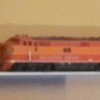As I mentioned, I took my AA pair to the club Saturday to try them out. Having never used a QSI decoder before it was a bit confusing.
After reading the basic Sunset literature, I powered on a unit, set the command cab to address 3 and tested the engine. It responds!
I ran it a bit and then did the same with the other A unit. Then I took each loco on the program track and set the road number address, start direction and analog mode.
I should say here that after some drilling around on the QSI website I found some Titan info to work from. The decoders have some commands unique to themselves so a thorough reading of the paperwork and careful testing helps with learning their quirks. There is a bit of additional programming to be done to these
The engine began moving at step 1, it crept at less than walking speed. Hmmm, amazing! Increased speed some, very smooth and quiet performance!
After running each engine a little individually and set up a consist to run them as a pair. I proceeded to run the pair around the club layout for some break in and listening. Very effortless pulling power, again very smooth. This is a great drive system.
Increased speed up to ‘20’ on the NCE handheld, again very smooth, powerful and quiet. The engine does not increase speed when increasing beyond ’20 to 28’. Top speed appeared to be about 40-45 scale mph. I believe this is a function of the decoder’s default speed table. I am going to dig in and see what happens with some re-programming of the speed table.
I ran the pair with a 9 car consist and they had no effort moving them around our grades of 2½%. I do want to total about 14-15 cars for the pair, so perhaps some weight may be needed. But not until I see the engines can’t handle the load.
The sound is outrageous! It started loud, I did fool with the wand a bit but didn’t get the knack to lowering the volume. The sound sets are great, there is a lot of interesting air releases, brake squeals, generator sounds and others.
I am completely satisfied with these engines. They have hit the proverbial home run with these drop-dead gorgeous engines. A very, very good engine for the price. There are one or two very minor items to correct, red markers lights up front for one. The bodies have amazing detail and the decoration is outstanding. I appreciate the road-specific items for the PRR units.
For the first time this Pennsy fan is actually slobbering.










